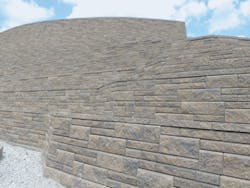Formidable Retaining Wall Blocks Replace Withered Sea Walls
In Part 2 of a 4-part series on retaining wall designs, author Carol Brzozowski illustrates two examples where encroaching wave erosion threatens two families’ cherished shoreline residences. In each, Brzozowski describes how site-specific projects can incorporate the effectiveness of large retaining wall blocks as they are linked naturally into shoreline-shaped segmental retaining walls. Ultimately, project designers and general contractors create retaining wall systems that boldly resist repetitious wave erosion and present landowners with uniquely nautical details—all the while preserving that highly desirable element of enabling landowner-access to the water’s edge.
A Gamut of Retaining Walls (Part 2) By Carol Brzozowski
The Shoreline Moves Closer
Following a storm in 2012, a Nova Scotia family found waves lapping at its doorstep. It wasn’t what the homeowners envisioned they’d ever be dealing with when they bought the property—after all, there had been a wall protecting the property from the waters of Shubenacadie Grand Lake. The house is located on an exposed point on its shores.
For homeowner Heather Fisher, the site had more than material value; the former camp with an old rock wall held sentimental value as the place where she and her husband had dated.
But that fortress came down in a storm. Fisher and her husband found themselves putting down sand bags and making other efforts to keep the water out.
George Searle of Searle Environmental Services Limited called it the “perfect storm”—a convergence of extreme high-water levels and strong winds for a long period of time. It destroyed the hand-built rock wall that had been in place for years and eroded the shoreline. The waves were breaking all the way up to the front door threshold, he says.
The Fishers initially asked Searle to install another natural stone wall. He recommended against that, reminding them that the peninsula location means when a Nor’easter blows through, it hits the shore hard.
Searle recommended the Fishers consider a Redi-Rock retaining wall as a solution. His firm had good results on a previous shorefront property installation.
Redi-Rock large-block retaining walls are built using 1-ton blocks to hold back the earth. Each block installed equals nearly 6 square feet of face, designed for efficiency in installation. The retaining wall blocks’ large size also enables tall gravity walls to be constructed without geogrid in many applications and allows for even taller reinforced walls.
Searle designed the Redi-Rock wall as a gravity structure that relies on the sheer mass of the blocks to retain the soil. Redi-Rock’s precast segmental retaining wall system allowed Searle to design the wall to follow the shoreline.
“We were able to do this because of the way the system interlocks. It gives you flexibility to incorporate the natural curvature of the shore,” says Searle.
“We selected Redi-Rock for the weight and ballast it has,” he adds. “It is more than sufficient to deal with the wave energy here. There are a lot of worse cases in coastal situations in Nova Scotia, but it’s amazing the shoreline damage that can occur when you get a perfect storm on an inland lake like this.”
The Fishers agreed, visiting the office of wall manufacturer DuraCast to put in the order for the retaining wall blocks. Doug McLean of DuraCast had originally told them there were no blocks available, as his company was producing at capacity for another big job, and Heather Fisher was fearful of losing her home. However, McLean was able to pull blocks from his large order to supply the family with enough to install the base course of the shore protection wall. Over subsequent weeks, he was able to siphon off enough blocks for them finish the wall before the end of the summer when the storms started up again.
Kel-Greg Enterprises Ltd. removed the old stone wall, installed the new Redi-Rock wall farther back on the property, then used the original stones as toe protection in front of the new wall to address the wave action that could cause toe scouring.
The project included 350 Redi-Rock blocks equaling approximately 2,000 square feet plus 72 Redi-Rock caps. The new wall stands about a foot taller than the previous wall to offer more protection to the home.
In addition to shoreline protection, the project also included a boat launch incorporated with the wall.
The crew was able to install the entire project from the shore during the low-water period of June through September without staging any material or equipment below the ordinary high-watermark.
Heather Fisher says that in the three years the wall has been installed it has held up well. Even after melting ice crashes against it in the spring, she says, “the blocks all still look great.”
The Fishers are expanding the wall, which was the ¬recipient of the 2013 Rocky Award for “Residential Wall of the Year” from Redi-Rock International, an annual honor given to the best Redi-Rock project completed each year in the US, Canada, England, Wales, Ireland, Spain, Norway, and South Korea.
Close to the Water
In Grand Island, NE, a combination of solutions helped a homeowner keep water from coming onto his property. The combination included a sea wall, Versa-Lok retaining walls used as terraces, gabions for the shoreline, and pavers for the deck.
Mark Reinforth of Tilley Sprinkler Systems & Landscaping in Grand Island was called in to look at the project in fall 2013.
“Everybody likes keeping their house close to the water. With our fluctuating water table, that water coming up and down starts eroding everything away, and the homeowner knew that was going to happen,” says Reinforth.
A few years ago the homeowner had built a sea wall, but the contractor who did the work installed it incorrectly.
“We came back to repair it and get it so that Mother Nature doesn’t take any more of the sand away,” says Reinforth. “Eventually it will erode if you don’t control where the water goes and how the water gets away from the house.”
In spring 2014, Tilley Sprinkler Systems & Landscaping removed the vinyl sheet piling wall that had been installed incorrectly, reinstalled it properly, and anchored it back into the soil with Manta Ray Duckbill anchors. To ensure the solution would hold back bank erosion, Reinforth’s crew put down crushed riprap to help with the breaking of the waves coming from the lake. A paver walkway was installed, using poles and rope for a nautical theme.
For the project, Tilley crews went back about 10 feet “and because of the elevation, we had to put in another wall,” says Reinforth. “We used Versa-Lok Chestnut Blend and built steps down to the walkway. It’s about a 2.5-foot retaining wall. We have drainage that takes the water off of the house and the yard in that area and goes through a 6-inch sewer and drain pipe out to the lake.”
Versa-Lok segmental retaining walls are made from high-strength concrete units, dry-stacked, interlocked with pins, and set on granular leveling pads. The mortarless walls do not need frost footings, and when stabilized with geogrid soil reinforcement, the walls can be constructed 50 feet tall and higher.
In Part 2 of a 4-part series on retaining wall designs, author Carol Brzozowski illustrates two examples where encroaching wave erosion threatens two families’ cherished shoreline residences. In each, Brzozowski describes how site-specific projects can incorporate the effectiveness of large retaining wall blocks as they are linked naturally into shoreline-shaped segmental retaining walls. Ultimately, project designers and general contractors create retaining wall systems that boldly resist repetitious wave erosion and present landowners with uniquely nautical details—all the while preserving that highly desirable element of enabling landowner-access to the water’s edge. A Gamut of Retaining Walls (Part 2) By Carol BrzozowskiThe Shoreline Moves Closer Following a storm in 2012, a Nova Scotia family found waves lapping at its doorstep. It wasn’t what the homeowners envisioned they’d ever be dealing with when they bought the property—after all, there had been a wall protecting the property from the waters of Shubenacadie Grand Lake. The house is located on an exposed point on its shores. [text_ad] For homeowner Heather Fisher, the site had more than material value; the former camp with an old rock wall held sentimental value as the place where she and her husband had dated. But that fortress came down in a storm. Fisher and her husband found themselves putting down sand bags and making other efforts to keep the water out. George Searle of Searle Environmental Services Limited called it the “perfect storm”—a convergence of extreme high-water levels and strong winds for a long period of time. It destroyed the hand-built rock wall that had been in place for years and eroded the shoreline. The waves were breaking all the way up to the front door threshold, he says. The Fishers initially asked Searle to install another natural stone wall. He recommended against that, reminding them that the peninsula location means when a Nor’easter blows through, it hits the shore hard. Searle recommended the Fishers consider a Redi-Rock retaining wall as a solution. His firm had good results on a previous shorefront property installation. Redi-Rock large-block retaining walls are built using 1-ton blocks to hold back the earth. Each block installed equals nearly 6 square feet of face, designed for efficiency in installation. The retaining wall blocks’ large size also enables tall gravity walls to be constructed without geogrid in many applications and allows for even taller reinforced walls. Searle designed the Redi-Rock wall as a gravity structure that relies on the sheer mass of the blocks to retain the soil. Redi-Rock’s precast segmental retaining wall system allowed Searle to design the wall to follow the shoreline. “We were able to do this because of the way the system interlocks. It gives you flexibility to incorporate the natural curvature of the shore,” says Searle. “We selected Redi-Rock for the weight and ballast it has,” he adds. “It is more than sufficient to deal with the wave energy here. There are a lot of worse cases in coastal situations in Nova Scotia, but it’s amazing the shoreline damage that can occur when you get a perfect storm on an inland lake like this.” The Fishers agreed, visiting the office of wall manufacturer DuraCast to put in the order for the retaining wall blocks. Doug McLean of DuraCast had originally told them there were no blocks available, as his company was producing at capacity for another big job, and Heather Fisher was fearful of losing her home. However, McLean was able to pull blocks from his large order to supply the family with enough to install the base course of the shore protection wall. Over subsequent weeks, he was able to siphon off enough blocks for them finish the wall before the end of the summer when the storms started up again. Kel-Greg Enterprises Ltd. removed the old stone wall, installed the new Redi-Rock wall farther back on the property, then used the original stones as toe protection in front of the new wall to address the wave action that could cause toe scouring. The project included 350 Redi-Rock blocks equaling approximately 2,000 square feet plus 72 Redi-Rock caps. The new wall stands about a foot taller than the previous wall to offer more protection to the home. In addition to shoreline protection, the project also included a boat launch incorporated with the wall. The crew was able to install the entire project from the shore during the low-water period of June through September without staging any material or equipment below the ordinary high-watermark. Heather Fisher says that in the three years the wall has been installed it has held up well. Even after melting ice crashes against it in the spring, she says, “the blocks all still look great.” The Fishers are expanding the wall, which was the ¬recipient of the 2013 Rocky Award for “Residential Wall of the Year” from Redi-Rock International, an annual honor given to the best Redi-Rock project completed each year in the US, Canada, England, Wales, Ireland, Spain, Norway, and South Korea. Close to the Water In Grand Island, NE, a combination of solutions helped a homeowner keep water from coming onto his property. The combination included a sea wall, Versa-Lok retaining walls used as terraces, gabions for the shoreline, and pavers for the deck. Mark Reinforth of Tilley Sprinkler Systems & Landscaping in Grand Island was called in to look at the project in fall 2013. “Everybody likes keeping their house close to the water. With our fluctuating water table, that water coming up and down starts eroding everything away, and the homeowner knew that was going to happen,” says Reinforth. A few years ago the homeowner had built a sea wall, but the contractor who did the work installed it incorrectly. “We came back to repair it and get it so that Mother Nature doesn’t take any more of the sand away,” says Reinforth. “Eventually it will erode if you don’t control where the water goes and how the water gets away from the house.” In spring 2014, Tilley Sprinkler Systems & Landscaping removed the vinyl sheet piling wall that had been installed incorrectly, reinstalled it properly, and anchored it back into the soil with Manta Ray Duckbill anchors. To ensure the solution would hold back bank erosion, Reinforth’s crew put down crushed riprap to help with the breaking of the waves coming from the lake. A paver walkway was installed, using poles and rope for a nautical theme. For the project, Tilley crews went back about 10 feet “and because of the elevation, we had to put in another wall,” says Reinforth. “We used Versa-Lok Chestnut Blend and built steps down to the walkway. It’s about a 2.5-foot retaining wall. We have drainage that takes the water off of the house and the yard in that area and goes through a 6-inch sewer and drain pipe out to the lake.” Versa-Lok segmental retaining walls are made from high-strength concrete units, dry-stacked, interlocked with pins, and set on granular leveling pads. The mortarless walls do not need frost footings, and when stabilized with geogrid soil reinforcement, the walls can be constructed 50 feet tall and higher. [text_ad] “The first vinyl sheet piling wall was about 3 feet out of the ground, and then we go back about another 2.5 to 3 feet,” says Reinforth. “He had another existing wall closer to the house on one side that was 2.5 feet. We’re looking at 8 feet of elevation and probably about 50 to 60 feet of wall. We had to do multiple levels and use terracing so that we were able to use the property; otherwise, it was just one big slope.” Reinforth says his biggest challenge was in removing the existing wall and putting it back to his company’s specifications. “This is the first time we had to take out something that was there and try to reuse it and put it back correctly,” he says. “Another challenge was making sure everything drained either into drains or on a gradual enough slope so that we didn’t have erosion again. “Using the combination of products of ShoreGuard vinyl sheet piling, retaining wall block, pavers, and drain systems, it creates something that’s aesthetic plus functional. That’s what we do, and we were able to accomplish that on this project. I think it turned out pretty nice.”“The first vinyl sheet piling wall was about 3 feet out of the ground, and then we go back about another 2.5 to 3 feet,” says Reinforth. “He had another existing wall closer to the house on one side that was 2.5 feet. We’re looking at 8 feet of elevation and probably about 50 to 60 feet of wall. We had to do multiple levels and use terracing so that we were able to use the property; otherwise, it was just one big slope.”
Reinforth says his biggest challenge was in removing the existing wall and putting it back to his company’s specifications.
“This is the first time we had to take out something that was there and try to reuse it and put it back correctly,” he says. “Another challenge was making sure everything drained either into drains or on a gradual enough slope so that we didn’t have erosion again.
“Using the combination of products of ShoreGuard vinyl sheet piling, retaining wall block, pavers, and drain systems, it creates something that’s aesthetic plus functional. That’s what we do, and we were able to accomplish that on this project. I think it turned out pretty nice.”


